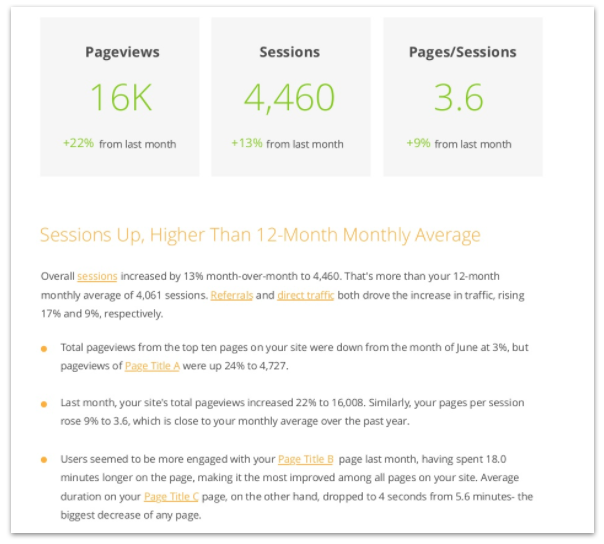This post is part of our Spotlight series featuring AI-powered companies and products that marketers can use to drive performance and transform their careers.
 Narrative Science (@narrativesci), which provides advanced natural language generation (NLG) technology to clients like the U.S. government, MasterCard and Deloitte, got its start as an academic project—developed in part by cofounder and Chief Scientist Kris Hammond (@KJ_Hammond)—that generated stat recaps for baseball games using artificial intelligence.
Narrative Science (@narrativesci), which provides advanced natural language generation (NLG) technology to clients like the U.S. government, MasterCard and Deloitte, got its start as an academic project—developed in part by cofounder and Chief Scientist Kris Hammond (@KJ_Hammond)—that generated stat recaps for baseball games using artificial intelligence.
But baseball was just the beginning. Fast forward six years and Narrative Science has more than $30 million in funding, a suite of NLG products that turn business and marketing data into content marketing stories at scale (think thousands of articles or reports in less time than it takes human writers to write one), and a burning desire to transform how companies interact with their information.
We recently caught up with Katy De Leon (@KatyDeLeon), VP of marketing at Narrative Science, to learn more about the company, content generation use cases for marketers, and their thoughts on artificial intelligence in marketing.
In a single sentence or statement, describe Narrative Science.
Narrative Science is a rapidly growing SaaS provider of advanced natural language generation (NLG) software called Quill. Powered by artificial intelligence, Quill helps companies across multiple industries transform data into narratives—stories—that improve decision-making, increase employee productivity and provide a better customer experience.
How does the company use artificial intelligence (i.e. machine learning, natural language generation, natural language processing, deep learning, etc.)?
Our platform, Quill, is an intelligent system that uses a combination of advanced analytics, natural language generation, machine learning, and other core artificial intelligence concepts.
Its various learning mechanisms are designed around interactivity so every time a user works with Quill, it gets smarter by learning about specific domains and how to describe them. For example, Quill can capture and integrate the nuance of how a particular company talks about its business. This type of learning results in new ways for Quill to describe and characterize the area of the business it is being asked to write about (e.g. sales performance, customer communications, employee feedback, etc.).
Quill also tracks edits made to the auto-generated narratives in order to create a set of language preferences that can be easily reused by an individual or across an organization.

What do you see as the limitations of artificial intelligence as it exists today?
We are in the very early stages of artificial intelligence so it is a difficult question to answer, but one limitation I would highlight is transparency.
At Narrative Science, we’ve always believed the ability for intelligent machines to communicate their reasoning as to how and why they made the decisions they made will be essential to the successful adoption of AI. We also believe that these systems need to be designed to communicate in the most common way that humans communicate—through language and conversation—or else we’ll be designing systems that are too difficult to use and impossible for us to understand, which will limit adoption.
This belief has been fundamental to our company from the day it was founded six years ago and more research is coming out that supports our view.
For example, Stanford recently published a One Hundred Year Study on Artificial Intelligence that envisions the arc of AI over the next century and recommendations for its success. The report states: “Design strategies that enhance the ability of humans to understand AI systems and decisions (such as explicitly explaining those decisions), and to participate in their use, may help build trust and prevent drastic failures, it's critical that engineers and designers create systems that communicate freely about how they work.”
While transparency is lacking in intelligent systems today, progress is consistently occurring.
What do you see as the future potential of artificial intelligence in marketing?
Again, we’re in the early stages, but the potential is vast.
For marketing specifically, we’re already seeing AI being applied in very tangible ways like automated web design and content creation, personalization of campaign copy based on individuals’ brand preferences, and the identification of patterns in social media data to make helpful product recommendations.
AI is going to make a huge impact on every function and marketing is no different. We’re just seeing the beginning of it.
What makes Narrative Science different than competing or traditional solutions?
While NLG isn’t necessarily new, the application of it within real-world scenarios (outside of academic circles) is only possible now given the recent explosion of data and advances in analytics and software development.
The unique design of Quill, in contrast to every other system, is that it does not start with the data—it starts by understanding the intent of, and audience for, a particular communication. The difference between Quill and basic data-to-text or template-based systems is that Quill knows what is important and interesting, provides context, and structures a narrative that is relevant to the intended audience, at scale.
Also, Quill is an enterprise-grade system that has been proven to meet the security and content quality requirements of heavily regulated industries like financial services and the U.S. intelligence community.
Who are the prototype customers in terms of company size and industries?
Quill is being used by enterprise organizations in many industries, including financial services, retail, insurance, consulting and the federal government. Specific customers are USAA, American Century Investments, Deloitte, Groupon, Credit Suisse, MasterCard, Franklin Templeton and the U.S. intelligence community.
We also offer an application for Google Analytics users, called Quill Engage, that is used by over 16,000 website owners, small businesses and marketing agencies. It’s an affordable natural language reporting tool that provides easy-to-read and insightful narrative reports about website performance.
What are the primary use cases of your product(s) for marketers?
We have a few different solutions for marketers.
1. Automated Product Descriptions
As you know and digital marketers know, engaging web content is critical when selling products through digital channels, whether explaining a real estate property’s best features or a spa’s unique amenities.
But ecommerce sites and retailers struggle to ensure their product descriptions are always up-to-date, optimized for search and mobile, and driving click-thrus and conversions. These companies use Quill to automatically write engaging, variable product descriptions that include key SEO-friendly terms that are tailored for mobile or desktop consumption. With automatically generated descriptions, our customers attract and retain online visitors with unique content that drives traffic and improves SEO rankings.
2. Google Analytics Insights
In-house digital marketers and marketing agencies alike struggle to understand what is driving website performance, whether it's because they aren’t fully trained on Google Analytics or they simply don’t have enough time.
Quill Engage automatically transforms Google Analytics data into actionable natural language reports. By quickly and easily explaining what's impacting site performance, Quill Engage enables organizations to make better decisions about user engagement, ad spend and specific campaign efforts.

3. Automated Portfolio Commentary
Asset management firms have to deliver portfolio commentary to clients that explain fund performance. Marketing teams are often tasked with analyzing this data and writing the commentary, requiring an enormous amount of time that could be spent on more valuable work (e.g. strategy and thought leadership).
These companies are using Quill to generate portfolio commentary in seconds that automatically incorporates their style, tone and guidelines, ensuring commentary is written in a consistent and compliant manner. Quill also enables employees to generate commentary on the fly, in real-time, so they can prepare information for any meeting whenever they need to.
Any other thoughts on AI in marketing, or advice for marketers who are just starting to explore the possibilities of AI?
Don’t be intimidated by the term and make sure you take enough time to understand if the technologies you are evaluating are well suited to solve your problem. There is so much buzz around AI, it can seem more complicated than it is.
I suggest starting with the problem first and then narrowing down the possible solutions for you to evaluate. Figure out what processes in your organization are candidates for automation. Understand the business questions you want answered that require massive amounts of data to answer them. Identify potential opportunities to monetize or squeeze more value out of your data.
One suggested resource is this webinar that explains the different enterprise applications of AI and when you should apply them (you can watch it here).
Paul Roetzer
Paul Roetzer is founder and CEO of Marketing AI Institute. He is the author of Marketing Artificial Intelligence (Matt Holt Books, 2022) The Marketing Performance Blueprint (Wiley, 2014) and The Marketing Agency Blueprint (Wiley, 2012); and creator of the Marketing AI Conference (MAICON).



